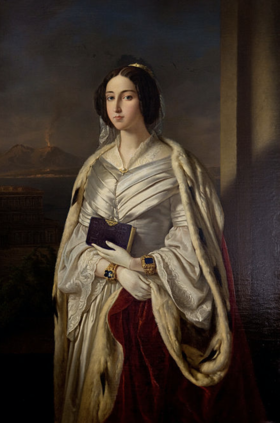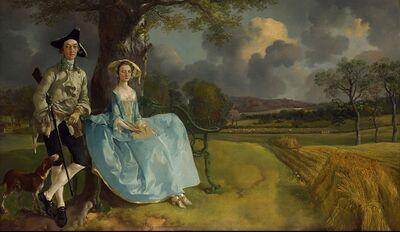Mariya Angelika of Reza
|
| ||||||||||||||||||
Princess Mariya Angelika vas Marius Barbanov (Common: Maria Angelica), nicknamed Blackwing, was a Haeseni princess and member of House Barbanov, later marrying Duke Adrian of Adria and thus becoming the Duchess-Consort of Adria. She'd become the female face of the Holy Orenian Empire when her husband was elected to the position of Lord Protector in 1731 following the death and scandal of Alexander II. However, she would never rise to the coveted position of Empress-Consort of Oren, as her husband passed of sickness only a day before his planned coronation.
As the eldest daughter of King Marius II and his primary consort, the late Valera of Adria, she was additionally bestowed the titular honor of Princess-Royal at birth.
Contents
Early life
Princess Mariya of Haense was born on the 15th of the Deep Cold, 1703, to the Crown-Prince King Marius II, and his consort, the Lady Valera of Adria. She was the firstborn child to the pair, and thus her birth marked the creation of the Crown Prince's future royal family. Though she was not the son and heir in which the Kingdom awaited, a child born of a union between Carrion and Barbanov provided much stability for the Hanseti monarchy, as well as securing hopes for the Princess-Consort’s fertility. As the first princess of the newly built city of Reza, she was additionally bestowed the honorific title of ‘Princess-Royal of Reza’, a tradition customary to the firstborn daughter of a new capital. A year later, Mariya’s only other full-blooded sister was born: Sofiya Theodosiya.
Overcome with stress at her lack of producing an heir, Mariya's mother Valera grew weaker, and would eventually succumb to ill-health during the birth of her third and only child, a son whom would pass three days later. This left a three year old Mariya without any maternal influence throughout her childhood, further creating difficulties with the Princess' relationship with her Father. Valera’s parentage and death, as well as the death of her son, Mariya’s brother, would be shrouded in mystery and various theories, leading the young princess to make many assumptions for herself. She commonly asserted that her brother was smothered by her Father, rather than dying of ill-health, due to the scandal that posed Valera’s true parentage as one of an incestuous nature, and that she was in fact, not a Carrion at all.
Therefore, Mariya's care was entrusted to her distant relative Aleksandra Ruthern, aided by her husband [{Josef Eimar, Red Prince of Muldav|Josef, Red Prince of Muldav]]. For extended periods of time the Princess lived within the Alimar Estate, allowing for her to become quick companions with the pair's two sons: Kazimar (who would later marry her sister Sofiya), and Vladrick.
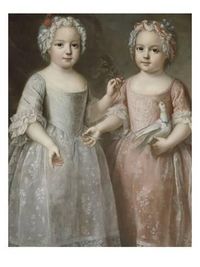
With the ongoing War of Two Emperors, Mariya faced several more family tragedies. Her two pseudo-uncles Godfric and George Alimar were executed by Renatian forces, and her Father was later assassinated within the palace courtyard. When Mariya was twelve, Josef and Aleksandra returned her care to the palace, with Josef passing of illness later that year. The Princess grew pensive and fear-ridden, believing herself to be cursed by way of her suspected incestuous grand-parentage.
Mariya would become acquainted with the lady Milena of Adria upon her arrival in Reza from the shores of Aeldin. Milena, quick-witted, befriended the headstrong princess in order to win her support in her bid for Andrik III’s queenship. As one of her first companions beyond the Alimars, Mariya’s friendship with Milena would continue onward into their lives- to the Barbanov, being one of a trustworthy foundation. Yet, in considering later events to transpire, the true nature of their friendship from Milena’s point of view is disputed. Mariya’s sister Sofiya would return from Aeldin soon after, and the three would form the core of Milena’s royal court.
Marriage Controversy
In her early teenage years, Princess Mariya shared a brief courtship with Renatian Knight Tiberius Tiber. However, her first formal betrothal would come in 1726 to her close childhood friend, Vladrick Alimar. Vladrick had travelled away from court for the years prior, and it was rumoured that Mariya had in fact broken off relations with Tiberius upon hearing of the Alimar’s return, now titled the Prince of Rubern. The two were a happy pair, remaining betrothed for a number of years due to delays in the construction of Rubern.
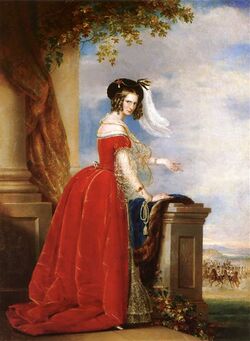
It was during this time in which the Duke of Adria, Adrian Sarkozic, contacted Sofiya via letter, asking her for advice in seeking a Hanseti bride. He was promptly suggested Mariya; Sofiya’s intention was to undermine her union with Vladrick, as she commonly expressed her distaste for the man. Adrian, eager for the prospect of a Barbovi alliance, travelled to Reza in order to prepare a meeting with the two sisters.
Adrian arrived alongside a large retinue of soldiers, boasting the lively success of his re-emerging Duchy to the two princesses. He would quickly request Mariya’s hand in marriage, expressing his will for an alliance between their two respective political states. Mariya found herself blindsided within this meeting, having had no prior warning of Adrian's true intentions. She immediately refused the betrothal, citing her current engagement to the Prince of Rubern. Sofiya mocked this show of faithfulness, continuing to urge her toward the Duke's proposal as the meeting continued.
Adrian himself aided in Sofiya’s quest to defame the Alimar prince, noting his emotional tendencies as well suggesting that his lands and stronghold, the Principality of Rubern, would turn against the crown of Haense and an alliance would prove detrimental. It was in this that Mariya relented- if anything, she was a woman wholly devoted to her Kingdom and it’s wellbeing. After significant negotiations, she hesitantly agreed to the proposed union on the grounds that Adrian formally petitioned the court of her brother.
However, before such a petition could be made officially, considerable scandal would be placed upon the betrothal. Mariya, wracked with guilt and fear in her decisions, failed to inform Vladrick of her intention to dissolve their engagement. Within a festival held for Emperor Alexander II’s coming-of-age ceremony, chaos erupted. Mariya was made aware that in fact, the Duke was betrothed to two princesses at once- having not nullified his arrangements with the Princess Ester of Avalain prior to seeking Mariya’s hand. Within the confined space of the Imperial palace courtyards, Ester confronted Mariya, who then confronted Adrian. Vladrick, also present, caught wind of the going-ons, alongside Mariya’s brother, King Andrik III. With much emotional and political distress occurring between each party, the Duke of Adria began to panic- in worries the predicament would cost him an already tedious engagement with Mariya.
Adrian approached Mariya privately shortly after, elaborating upon the situation. The patriarch of Sarkozic, Edgar of Sarkoz, had rejected the idea of a Devereux union for Adrian, despite a betrothal already being in place. Threatening him with denouncing his heirship to the house, Adrian had rushed to seek an alternative bride, hence his intense pushing for Mariya’s favour, and his scheming alongside her sister. He expressed his apology for what had transpired, yet reaffirmed the political advantages of their potential union. Mariya, still at a loss for how wrong it had all gone, allowed the engagement to continue. Despite thinking the Duke pompous, entitled and arrogant- she saw her entrapment in the arrangement. Vladrick had spoken lengths of his desire to see both herself and Adrian dead after her betrayal, and without a marriage to the Duke she would have nothing left.
Adrian promptly summoned the entirety of his retinue, travelling to Reza to finally petition King Andrik for her hand. Vladrick, who was present at the court, is said to have only laughed when Andrik granted Adrian Mariya’s hand in marriage. In a strange twist of irony, he would go on to court and later marry Adrian’s former betrothed, Princess Ester Devereux. Cordial, yet cold, Mariya and Adrian exchanged letters for the following months, the Princess making occasional visits to the newly constructed township of Renzfeld.
In a grand ceremony befitting the alliance of Carriondom to come, the pair wed upon the 8th of the Sun’s Smile, 1729. In attendance were hundreds of guests, amongst them members of Barbanov, Sarkozy, Imperials, and even select members of a Ruberni delegation; Vladrick himself included.
As Duchess of Adria
Following the wedding, Mariya relocated to the township of Renzfeld, the capital of the Duchy of Adria. A solemn, yet dutiful duchess, she thrust herself into the various roles of her position, finding solace in the straightforwardness and simplicity of her work. Her sister Sofiya aided her immensely, the woman enjoying the climate and activity of the town.
Two years after their marriage, the ducal pair would welcome their first child- a healthy baby boy, bearing a strong resemblance to Adrian, yet possessing Mariya’s Barbanov blue eyes. The child was christened Joseph Clement de Sarkozy. Struggling to connect emotionally with her child, whomst would never settle in the care of his Mother- Mariya resorted to leaving much of his care and upbringing to the courtiers. Motherhood proved an inherently difficult role in Mariya’s life, as she’d lacked a caring maternal influence in her own youth.
Mariya aided Adrian in numerous ventures internally within the Duchy, as well as relations beyond. She organised a restructure of Adrian court, re-defining the positions and roles within it. Though holding a tumultuous, and ultimately lacklustre marriage, the pair were propelled by a shared, devout patriotism to highlander beliefs and the protection of their respective birth realms.
It was within the same year of Joseph’s birth in which the Emperor Alexander II passed of sickness, leading to the ascension of Adrian to Lord-Protector of Oren in a unanimous decision by various vassal leaders.
Imperial Tenure
The house of Sarkozic, now rebranded as the imperialised name of de Sarkozy, then took residence within the Imperial city of Helena. Adrian sought to repair the fractured pieces of the Empire, starting with a total demolition, and reconstruction of the city. Mariya aided in small parts of the design, as well as overseeing the implementation of the newly minted Helena.
Throughout her newfound Imperial tenure, the Duchess lessened somewhat in her prior, cold demeanour. She began to once more handle affairs of court, organising a variety of events, and hosting a number of guests within the palace walls. Mariya bore another son- George Casimir, followed by two daughters- Philippa Valera, and Anna Sophia, their namesake after her mother and sister respectively.
It was in these years that Mariya was driven by a long-standing lust for power. Observing the meticulous Lord-Protectorship arrangements, she sported ideas of a new empire, one beneath the rule of Sarkozy. Adrian shared in this ideal, and the two began planning for an ascension to Emperor and Empress-Consort respectively, expecting to do so following the conclusion of the Orcish War. Though never born, nor raised to hold such a prestigious title, Mariya anticipated the day she’d be crowned with much fervour, eagerly embracing the opportunity. She began drafting extensive Imperial courtly reforms- drawing influence from the Empires of old, as well as the reforms made by her sister-in-law, the Queen Milena. Mariya had the Empress’ suite of the palace custom tailored to her, despite not yet having the public authority to do so. Upon the roof, a grand mural of Reza, and the walls lined with various Hanseni portraits and paintings.
Allegedly, she also had coronation garments covertly tailored, as well as a number of crowns befitting the image of an Empress-Consort. Certain correspondence spoke of a dramatic golden gown, decorated with intricate embroidery symbols of both her Hanseni and Imperial heritage. To accompany, both a red sash and a historic headpiece- a crown inspired by the one in which her Mother Valera had worn in a single instance, her wedding to the King Marius, and never again. The existence of said gown is contested, as no concrete proof was ever found.
However tragedy would strike the Empire, with the Lord Protector, Mariya's husband, falling ill and passing away shortly after his victory in the Orcish battle. With her plans shattered, now both widowed and without power, she fell into an extremely depressive state. From there onward, she lived between Helena and Haense- finding much grief in the memories held within the new Imperial Capital. Mariya wore the darkened colours of mourning for the remainder of her life, rarely seen outside of the confines of her room.
Mariya loathed her presence in an empire to which she would not be empress to, and worried immensely in being forgotten in history. Her later life was marked with considerable pain- reconnecting with her prior fiancee Vladrick only once, to which she discovered his blatant happiness with Ester. Mariys fell into her own mental turmoil, similarly to how her sister had in the few years prior, and was plagued with hatred and spite to the world around her.
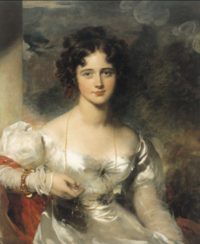
Death
Only a single year after Adrian’s death, Mariya paid a visit to the ruins of her prior home, Reza. The city had been demolished in favour of a new Hanseni city- leaving only the Cathedral, where Mariya was wed, and the Prikaz palace, where she had grown up. It was within the remnants of the Prikaz palace that the Duchess met a gruesome end- murdered assumedly by one opposing the Sarkozic regime. Her body was later recovered, though details of her death are left mostly unknown. No funeral was held, and nor was much attention paid to the Duchess-Dowager's passing, apart from the sentiments from the Queen Milena, and the Alimars.
Legacy
Following her murder, those handmaidens closest to Mariya delivered a series of letters- detailing her final words to numerous people, as well as leaving items to her will. It was assumed that she had written these letters in anticipation of her demise, yet strangely most were dated from before Adrian’s death- before she had spiraled into extreme depression. Among those receiving letters were the Queen Milena, her niece Karina, and Vladrick.
Months later, Queen Milena was officially crowned alongside her husband. She wore a dress with stark similarities to words spoken of the Duchess' alleged coronation gown, sparking theories that in fact, it was passed on to the Hanseni Queen. The dress has since become a symbol of Hanseni culture- worn by Milena’s succecessor, Maya of Muldav, for her coronation also.
However, in the years following Milena’s death- a number of letters would be made public, detailing the Queen’s tendencies for extramarital activities. Though the parentage of her children was proven to be Barbanov, much speculation continued- with a strong belief that she in fact had relations with Mariya’s husband, Adrian Sarkozic. This led to question the true nature of their public friendship across the years of their respective lives.
Mariya’s children would go on to continue the Imperial line- with her son, Joseph Clement, marrying the Princess Imperial and heir to the throne, Anne Augusta. Joseph Clement later rose to the position of Anne Augusta's co ruler, making the pair the Holy Orenian Emperor and Empress respectively. Through him, Mariya's line continues onward within the Imperial Royalty.
With a substantial collection of writings detailing each stage of her life, much is known about the Princess’ rise, and ultimate fall in power. Her name was later commemorated by the Queen Maya, in the form of the Marusvar Masquerade ball, held in her honour. Mariya’s story remains a Hanseni fable of fear, and the consequences of a lust for power.
"Yet if I’ve learnt anything from my time in the capital, it is that we must cherish the moments we can. I cherish that moment, even if I must return to a grimmer reality moments later. I advise you to do the same, Queen Milena. We cannot pour our hearts into each waking hour, for they will only fall subject to the pains of rulership." -Perhaps Mariyas most well-known quote, taken from her final letter to Queen Milena
Titles, styles, honours and arms
- 15th of The Deep Cold 1703 - 8th of the Sun’s Smile 1729: Her Royal Highness Princess Mariya Angelika, Princess Royal of Reza
- 8th of the Sun’s Smile, 1729 - 12 The Amber Cold, 1737: Her Royal Highness Princess Mariya Angelika, Duchess of Adria, Princess Royal of Reza
- 12 The Amber Cold, 1737 - 6th of the Grand Harvest, 1738 : Her Royal Highness Princess Mariya Angelika, Dowager Duchess of Adria, Princess Royal of Reza
Full title as Duchess of Adria
HER ROYAL HIGHNESS, Princess Mariya, Princess Royal of Hanseti-Ruska, Duchess of Adria, the Crownlands, Lorraine, and Roden, Baroness of Renzfeld
Issue
| Name | Birth | Death | Marriage | |
|---|---|---|---|---|
| Joseph II, Holy Orenian Emperor | 1st of Malin's Welcome, 1731 | 1814 | Anne I, Holy Orenian Empress | Firstborn child of Adrian and Maria. Sucessor of Adrian, Duke of Adria. Rose to the position of Holy Orenian Emperor following his marriage to Anne Augusta. |
| George Casimir, Count of Pompourelia | 19th of the First Seed, 1735 | 1797 | Henrietta, Princess of Alstion | Secondborn child of Adrian and Maria. Count of Pompourelia |
| Philippa Valeria de Sarkozy | 7th of the Grand Harvest, 1736 | 1740 | Unwed | Thirdborn child of Adrian and Maria. Died of smallpox en route to St Emma's Convent |
| Anna Sophia de Sarkozy | 12th of the Deep Cold, 1737 | 1742 | Unwed | Fourthborn child of Adrian and Maria. Died of smallpox en route to St Emma's Convent |
Ancestors
| Ancestors of Mariya Angelika of Reza | ||||||||||||||||||||||||||||||||||||||||||||||||||||||||||||||||||||||||||||||||||||||||||||||||||||||||||||||||||||||||||||||||||||||||||||||||||||||||||||||||||||||||||||||||||||||||||||||||||||||||||||||||||||||||||||||||||||||||||||||||||||||||||||||||||||||||||||||||||||||||||||||||||||||||||||||||||||||||||||||||||||||||||||||||||||||||||||||||||||||||||||||||||||||||||||||||||||||||||||||||||||||||||||||||||||||||||||||||||||||||||||||||||||||||||||||||||||||||||||||||||||||||||||||||||||||||||||||||||
|---|---|---|---|---|---|---|---|---|---|---|---|---|---|---|---|---|---|---|---|---|---|---|---|---|---|---|---|---|---|---|---|---|---|---|---|---|---|---|---|---|---|---|---|---|---|---|---|---|---|---|---|---|---|---|---|---|---|---|---|---|---|---|---|---|---|---|---|---|---|---|---|---|---|---|---|---|---|---|---|---|---|---|---|---|---|---|---|---|---|---|---|---|---|---|---|---|---|---|---|---|---|---|---|---|---|---|---|---|---|---|---|---|---|---|---|---|---|---|---|---|---|---|---|---|---|---|---|---|---|---|---|---|---|---|---|---|---|---|---|---|---|---|---|---|---|---|---|---|---|---|---|---|---|---|---|---|---|---|---|---|---|---|---|---|---|---|---|---|---|---|---|---|---|---|---|---|---|---|---|---|---|---|---|---|---|---|---|---|---|---|---|---|---|---|---|---|---|---|---|---|---|---|---|---|---|---|---|---|---|---|---|---|---|---|---|---|---|---|---|---|---|---|---|---|---|---|---|---|---|---|---|---|---|---|---|---|---|---|---|---|---|---|---|---|---|---|---|---|---|---|---|---|---|---|---|---|---|---|---|---|---|---|---|---|---|---|---|---|---|---|---|---|---|---|---|---|---|---|---|---|---|---|---|---|---|---|---|---|---|---|---|---|---|---|---|---|---|---|---|---|---|---|---|---|---|---|---|---|---|---|---|---|---|---|---|---|---|---|---|---|---|---|---|---|---|---|---|---|---|---|---|---|---|---|---|---|---|---|---|---|---|---|---|---|---|---|---|---|---|---|---|---|---|---|---|---|---|---|---|---|---|---|---|---|---|---|---|---|---|---|---|---|---|---|---|---|---|---|---|---|---|---|---|---|---|---|---|---|---|---|---|---|---|---|---|---|---|---|---|---|---|---|---|---|---|---|---|---|---|---|---|---|---|---|---|---|---|---|---|---|---|---|---|---|---|---|---|---|---|---|---|---|---|---|---|---|---|---|---|---|---|---|---|---|---|---|---|---|---|---|---|---|---|---|---|---|---|---|---|---|---|---|---|---|---|---|---|---|---|---|---|---|---|---|---|---|---|---|---|---|---|---|---|---|---|---|---|---|---|---|---|---|---|---|---|---|---|---|---|---|---|---|---|---|---|---|---|---|---|---|---|---|---|---|
|
|
||||||||||||||||||||||||||||||||||||||||||||||||||||||||||||||||||||||||||||||||||||||||||||||||||||||||||||||||||||||||||||||||||||||||||||||||||||||||||||||||||||||||||||||||||||||||||||||||||||||||||||||||||||||||||||||||||||||||||||||||||||||||||||||||||||||||||||||||||||||||||||||||||||||||||||||||||||||||||||||||||||||||||||||||||||||||||||||||||||||||||||||||||||||||||||||||||||||||||||||||||||||||||||||||||||||||||||||||||||||||||||||||||||||||||||||||||||||||||||||||||||||||||||||||||||||||||||||||||

